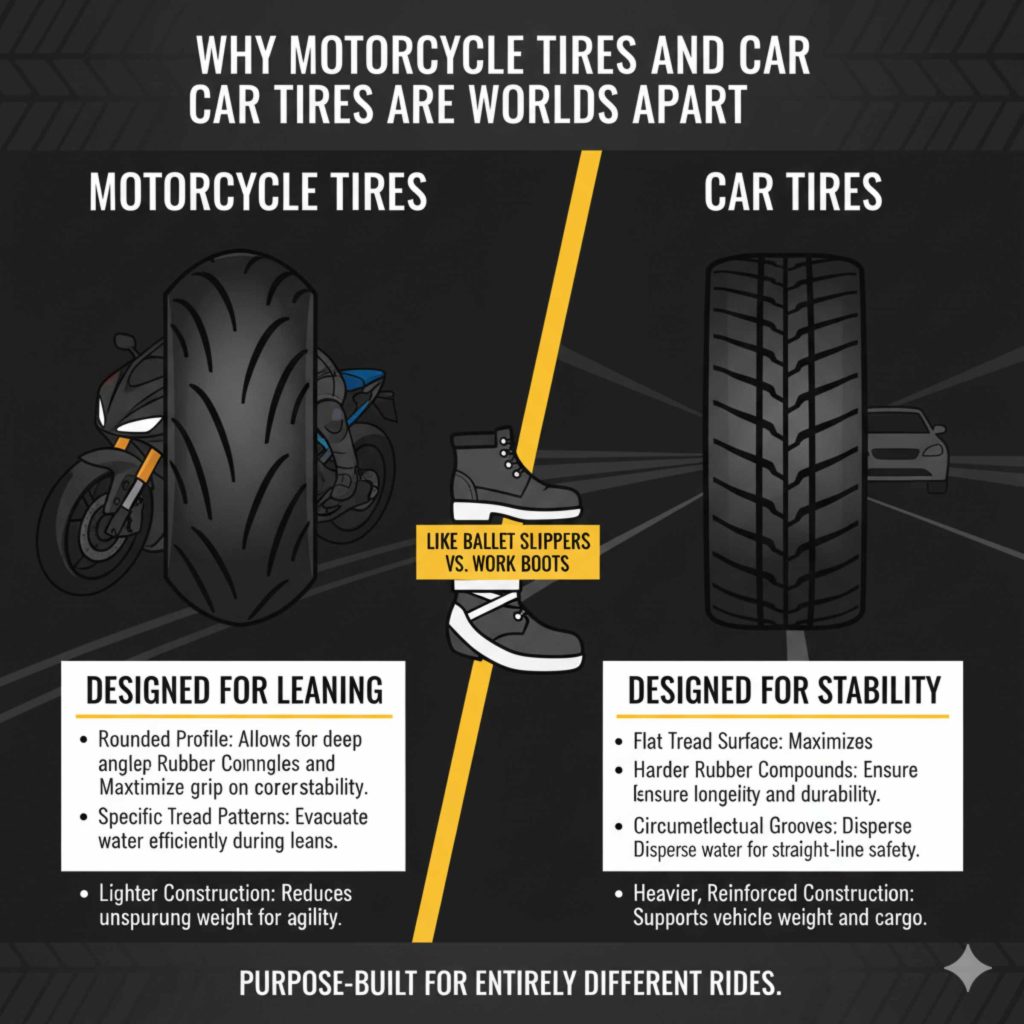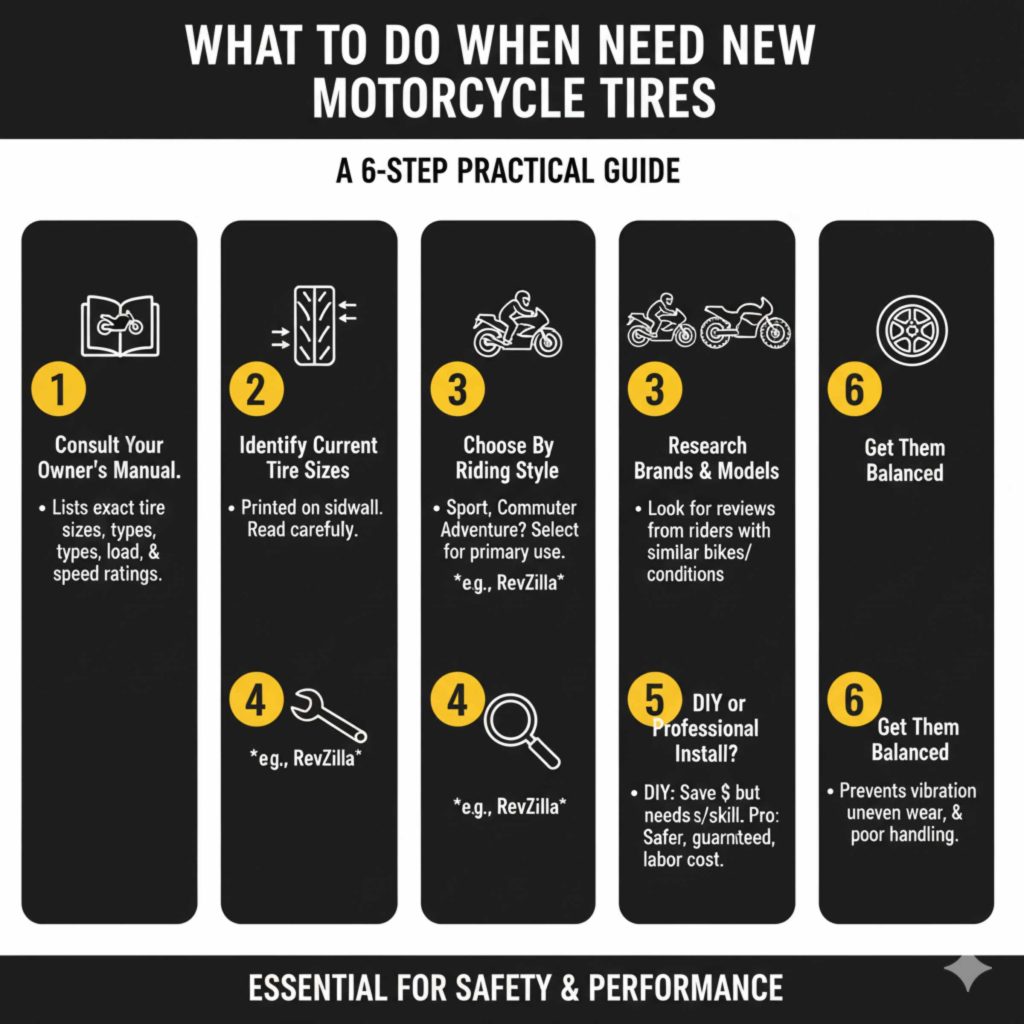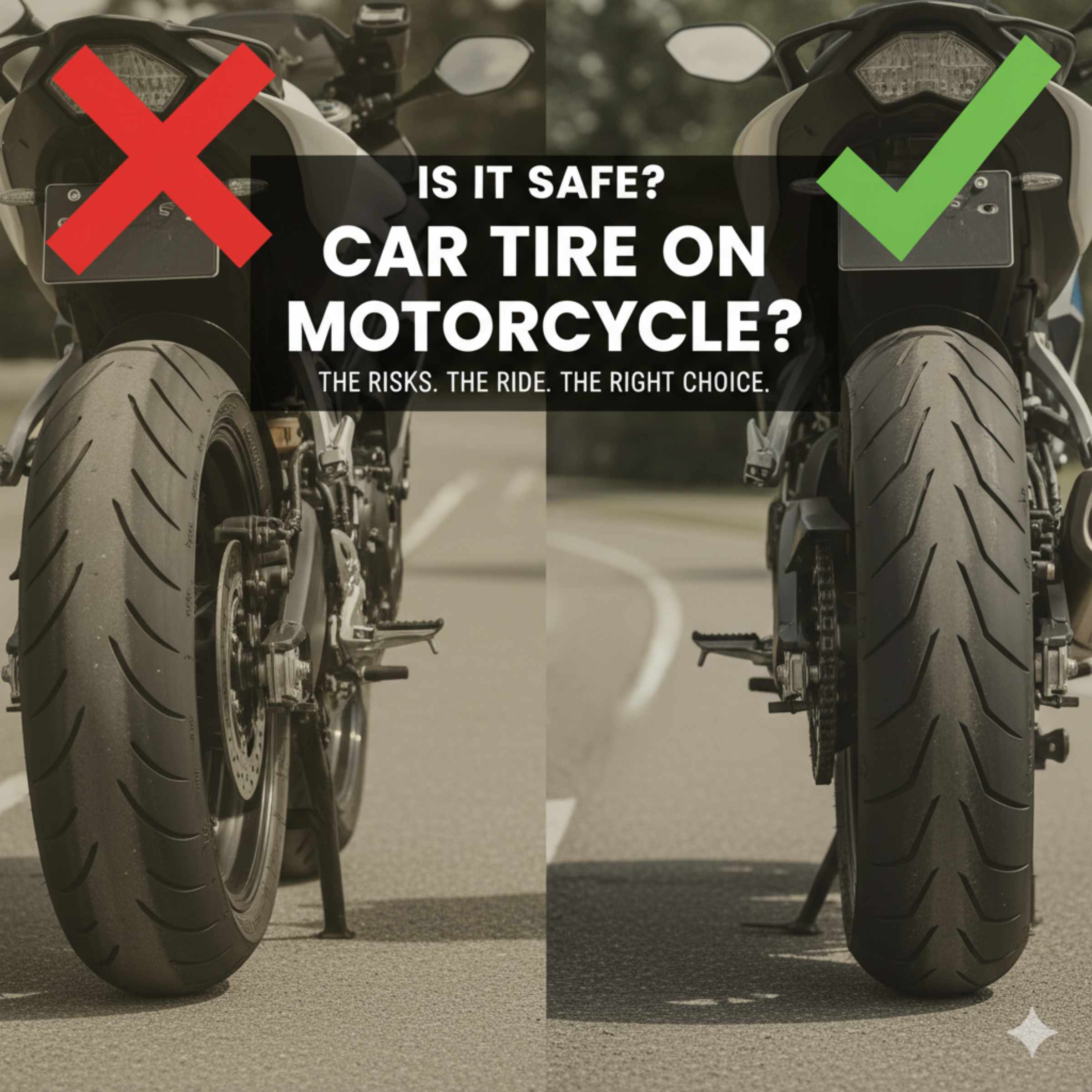Quick Summary:
No, it is absolutely NOT safe to use a car tire on a motorcycle. Motorcycle tires are specifically designed for the unique demands of two-wheeled vehicles, differing significantly in construction, profile, and handling characteristics from car tires. Using a car tire on a motorcycle is extremely dangerous and can lead to loss of control and serious accidents.
Ever found yourself wondering if you could just swap out a worn motorcycle tire for a spare car tire you have lying around? Maybe to save a few bucks or because it seems like a “good enough” fit? It’s an idea that pops into many riders’ heads, especially when facing unexpected tire wear or a tight budget. However, this is one area where “close enough” can have severe, even life-threatening, consequences. Motorcycle tires and car tires are designed from the ground up for very different jobs. Let’s break down exactly why they aren’t interchangeable and what you need to know to keep your ride safe and sound.
Why Motorcycle Tires and Car Tires Are Worlds Apart
At first glance, tires are just rubber circles that go on wheels, right? Wrong! When it comes to motorcycles and cars, the differences go much deeper. Think of it like trying to put a ballet slipper on a work boot – they might both cover a foot, but their purpose and design are entirely different.

Construction Differences: More Than Just Rubber
The way tires are built is a critical factor in their performance. Motorcycle tires have a fundamentally different internal structure compared to car tires.
- Carcass Layers (Plies): Motorcycle tires typically have fewer, but stronger, carcass plies that are layered in a way to allow the tire to flex and support the bike’s lean angles. This construction is crucial for stability when cornering. Car tires, on the other hand, have multiple plies designed to provide a flatter contact patch for straight-line stability and absorbing bumps from a heavier, four-wheeled vehicle.
- Sidewall Stiffness: Motorcycle tire sidewalls are designed to be more flexible to allow for the extreme angles of lean required in turning. Car tire sidewalls are much stiffer, built to support the weight of the vehicle and resist lateral forces when turning. This stiffness would severely hinder a motorcycle’s ability to lean and maneuver.
- Tread Pattern: Motorcycle tires often have grooved patterns that extend very close to the shoulder, allowing for maximum grip when leaned over. Car tires have tread patterns optimized for water displacement and even wear across a wider, flatter surface.
Profile and Shape: The Key to Cornering
This is arguably the biggest and most visually obvious difference. The shape of the tire’s cross-section is designed for how the vehicle handles.
- Curvature: Motorcycle tires are rounded, almost like a ball. This hemispherical shape allows the motorcycle to lean into turns naturally. As you lean the bike, a different part of the tire’s tread makes contact with the road, providing a smooth transition and stable cornering.
- Flatness: Car tires are designed with a much flatter profile. This creates a larger, uniform contact patch that is stable for straight-line driving and provides good grip for turning a four-wheeled vehicle directly. Trying to lean a motorcycle fitted with a flat car tire would be like trying to balance on a flat plank – it’s unstable and dangerous.
Load and Speed Ratings: Safety First
Every tire has specific ratings for the load it can carry and the speeds it can safely handle. These ratings are not interchangeable between vehicle types.
- Load Capacity: Motorcycle tires are rated for the weight of the motorcycle and rider(s), distributed across two points of contact. Car tires are designed to support much heavier vehicles with four points of contact and a wider distribution of weight. A car tire on a motorcycle might appear to handle the load, but its construction is not optimized for the concentrated stress points a motorcycle creates.
- Speed Rating: Tires are also rated for the maximum speed they can safely sustain. Exceeding these ratings can cause tire failure, a catastrophic event on a motorcycle. Car tire speed ratings, while sometimes high, are based on their intended use and construction, which is fundamentally different from a motorcycle tire.
The Dangerous Reality of Using a Car Tire on a Motorcycle
So, why is this a huge no-go? Let’s dive into the specific risks involved.
Loss of Control and Instability
The rounded profile of a motorcycle tire is non-negotiable for safe riding. A car tire’s flatter profile means:
- Wobbling and Instability: When you try to lean the motorcycle with a car tire, the tire won’t roll smoothly onto its edge. Instead, it forces the bike into an unnatural, wobbly state. This makes it incredibly difficult to maintain straight-line stability and almost impossible to corner safely.
- Sudden Tilting: Instead of a gradual lean, the motorcycle might abruptly drop or tilt to one side when you try to turn, especially at speed. This can cause the rider to lose balance instantly.
- Reduced Maneuverability: The ability to make quick, precise adjustments – essential for avoiding hazards – is severely compromised.
Compromised Braking and Grip
Tires are your only connection to the road. When that connection is compromised, your ability to stop and maintain traction is too.
- Reduced Contact Patch in Turns: While a car tire has a large contact patch for straight driving, this patch shifts drastically and poorly when the bike is leaned. This dramatically reduces the grip available for cornering, increasing the risk of skidding.
- Overheating: The design of a car tire doesn’t dissipate heat as effectively under the unique stresses of motorcycle use. Overheating can lead to tire degradation and potential failure.
- Uneven Braking Performance: The way a car tire interacts with the road surface is optimized for four wheels. On a motorcycle, this can lead to unpredictable and less effective braking, especially during hard stops.
Risk of Tire Blowout or Failure
Car tires are not built for the forces a motorcycle exerts. The constant flexing, the stresses of leaning, and the heat generated can all contribute to a tire failure.
- Structural Integrity: The internal structure of a car tire can be overwhelmed by the unique stresses of motorcycle cornering and acceleration.
- Sudden Deflation: A catastrophic failure, like a blowout, on a motorcycle at speed is incredibly dangerous and can be unsurvivable.
Legal and Insurance Issues
Beyond the safety concerns, there are practical ramifications.
- Legality: In many places, using a tire not designed for the vehicle type it’s fitted to can be illegal. You could face fines if caught.
- Insurance: If you are involved in an accident while using improper tires, your insurance claim could be denied. This could leave you responsible for all damages and medical costs.
For more on tire safety and regulations, the National Highway Traffic Safety Administration (NHTSA) offers valuable insights into vehicle equipment safety standards.
What to Look for in a Motorcycle Tire
Now that we know what NOT to do, let’s talk about what makes a motorcycle tire the right choice.
Tire Size and Specifications
This is the most fundamental aspect. Your motorcycle’s manual will specify the exact tire sizes for both the front and rear wheels. These are usually printed on the tire’s sidewall.
- Example: A common front tire size might be “120/70ZR17” and a rear might be “180/55ZR17.
- Understanding the Numbers:
- 120/180 = Tire width in millimeters.
- 70/55 = Aspect ratio (sidewall height as a percentage of width).
- Z/R = Speed rating (Z for over 149 mph, R for Radial construction).
- 17 = Rim diameter in inches.
Always match these specifications precisely. Deviating significantly can impact handling and stability.
Tire Construction (Bias-Ply vs. Radial)
Motorcycle tires come in two main types of construction:
- Bias-Ply: Historically more common, these tires have carcass plies that run diagonally across the tire from bead to tread. They are generally more affordable and offer good durability for everyday use.
- Radial: These tires have plies that run radially across the tire from bead to bead, with a belt layer under the tread. They offer better handling, stability at higher speeds, and a larger contact patch for improved grip, especially when leaning. Most modern performance and touring motorcycles use radial tires.
Mixing bias-ply and radial tires on the same motorcycle is generally not recommended and can negatively affect handling. Stick to the type recommended by your motorcycle manufacturer.
Tread Pattern and Compound
The tread pattern and the rubber compound are designed for specific riding conditions and performance needs.
- Sport Tires: Aggressive tread patterns with softer compounds for maximum grip on dry pavement, designed for cornering.
- Touring Tires: Deeper tread grooves for water evacuation and often with harder compounds for longer mileage and comfort.
- Dual-Sport Tires: Knobby or semi-knobby patterns for off-road traction, but still designed to be safe on pavement for the ride to the trail.
Load and Speed Ratings
These are critical safety features imprinted on the tire sidewall.
- Load Index: A numerical code indicating the maximum load carrying capacity of a tire.
- Speed Rating: An alphabetical letter indicating the maximum speed capability.
Always replace tires with ones that meet or exceed the manufacturer’s original load and speed ratings. Never use a tire with a lower rating.
A Simple Comparison: Car Tire vs. Motorcycle Tire
To clearly illustrate the differences, let’s look at them side-by-side.
| Feature | Car Tire | Motorcycle Tire |
|---|---|---|
| Profile/Shape | Flat and wide, designed for linear contact patch. | Rounded, designed for gradual lean angles and changing contact patch. |
| Construction | Multiple, stiff sidewall plies for vehicle support. | Fewer, more flexible plies for lean maneuverability and different stress distribution. |
| Tread Pattern | Optimized for water evacuation and even wear across a flat surface. | Grooves designed to provide grip at extreme lean angles, specific to riding style. |
| Handling in Turns | Highly unstable, “fall asleep” over to one side, no smooth transition. | Smooth, stable transitions allowing for controlled cornering. |
| Intended Use | Support heavy loads, four points of contact, primarily straight-line stability. | Support lighter loads, two points of contact, extreme lean angles for control. |
| Load/Speed Ratings | Designed for vehicle weight and speeds of cars. | Designed for motorcycle weight and speeds, incorporating lean forces. |
What to Do When You Need New Motorcycle Tires
Replacing motorcycle tires is essential for safety. Here’s a practical guide:
1. Consult Your Owner’s Manual
Your motorcycle’s manual is your best friend. It will list the exact tire sizes, types, load ratings, and speed ratings recommended by the manufacturer. Don’t guess – check!
2. Identify Your Current Tire Sizes
If you don’t have the manual, the tire sizes are printed on the sidewall of your current tires. Read them carefully, noting every number and letter.
3. Choose Tires Based on Your Riding Style
Are you a sport rider who loves carving corners? A commuter who racks up miles? Or an adventure rider tackling various terrains? Select tires designed for your primary use. For example, RevZilla, a reputable motorcycle gear retailer, offers a wide selection and helpful filters to find the right tire for your needs.
4. Research Tire Brands and Models
Once you know the size and type, research reputable tire brands and models. Look for reviews from other riders who own similar motorcycles and ride in similar conditions.
5. Decide: DIY or Professional Installation?
Mounting motorcycle tires can be tricky. It requires specialized tools and technique to avoid damaging the tire or the rim.
- DIY Pros: Can save money on labor costs.
- DIY Cons: Requires specialized tools (tire spoons, bead breaker, valve core tool), significant skill and practice, risk of damage if done incorrectly.
- Professional Pros: Done by experienced technicians, proper tools, usually guarantees the work, safer if you’re unsure.
- Professional Cons: Labor costs add to the overall price.
For beginners, having a professional install your tires is often the safest bet. Many motorcycle shops and even some auto repair shops that work on motorcycles can perform this service.
6. Get Them Balanced
After mounting, tires must be balanced. This involves adding small weights to the rim to counteract any uneven weight distribution in the tire and wheel assembly. An unbalanced tire will cause vibration, uneven wear, and poor handling.

Frequently Asked Questions (FAQ)
Q1: Can I put a car tire on the rear wheel of my motorcycle?
No, for the same reasons it’s unsafe on the front. The profile, construction, and handling characteristics are fundamentally different and will lead to severe instability and loss of control.
Q2: What happens if I try to lean a motorcycle with a car tire?
The motorcycle will likely feel extremely unstable and may wobble uncontrollably. It might feel like the bike wants to “fall asleep” to one side or the other, making safe cornering impossible and increasing the risk of a crash.
Q3: Are there any exceptions? Are there any motorcycle-like vehicles that use car tires?
Some very specialized vehicles, like certain trikes (three-wheeled vehicles) or custom builds, might use car tires, but these have significantly different chassis designs, suspension, and steering geometry than a traditional motorcycle. They are not designed to lean like a motorcycle. For a standard two-wheeled motorcycle, the answer is always no.
Q4: My car tire looks like it fits the rim. Is that enough?
No, a tire fitting the rim diameter and width is only the first very basic step. The internal construction, profile, the way it supports forces, and the intended use are far more critical for safe motorcycle operation. A car tire will not perform like a motorcycle tire, even if it physically mounts onto the wheel.
Q5: What are the signs that my motorcycle tires need replacing?
Look for worn-out tread patterns (especially the wear indicators), cracks in the sidewalls, bulges, or flat spots. If the tire feels unstable or doesn’t grip well, it’s also a sign it’s time for replacement.
Q6: Can using the wrong tire void my insurance?
Yes, absolutely. If an accident occurs and it’s determined that improper tires (like a car tire on a motorcycle) contributed to the incident, your insurance company can deny your claim. This is a significant financial and personal risk.
Q7: Where can I find reliable information about motorcycle tire specifications?
Always start with your motorcycle’s owner’s manual. You can also find excellent resources from reputable motorcycle manufacturers, tire manufacturers’ websites, and respected motorcycle safety organizations.
Conclusion
As a rider, your safety is paramount, and your tires are arguably the most critical component connecting you to the road. The idea of using a car tire on a motorcycle may seem like a tempting shortcut, but the evidence is clear: it is a fundamentally unsafe practice.
Motorcycle tires are meticulously engineered with specific profiles, constructions, and materials to handle the unique dynamics of two-wheeled travel – especially the act of leaning into turns. Car tires, designed for a completely different purpose, simply cannot replicate this required performance. The risks of instability, compromised grip, and catastrophic tire failure are far too high.
Always adhere to your motorcycle manufacturer’s recommendations for tire size, type, load rating, and speed rating. Invest in proper motorcycle tires from reputable brands, and if you’re not comfortable with installation, seek professional help. Your confidence on the road – and your ability to arrive home safely – depends on it.

